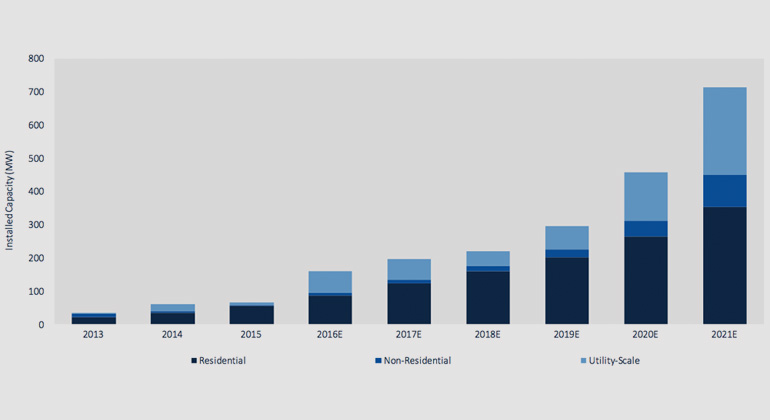German Energy Storage Market to Reach $1B by 2021
GTM Research’s latest report provides a roadmap for one of the world’s most successful storage markets.
According to a new report from GTM Research, The German Energy Storage Market: 2016-2021, Germany’s energy storage market will grow elevenfold in megawatt terms between 2015 and 2021 to reach an annual value of $1.03 billion.
Germany is already one of the world’s leading energy storage markets. At the end of 2015, Germany was home to 67 megawatts of energy storage (128 megawatt-hours) with a value of $169 million. Factors including the nation’s declining feed-in tariffs, high retail electricity rates and abundance of installed renewables make it an attractive market for the energy storage value proposition.
According to the report, retail electricity prices for residential customers in Germany have increased 47 percent since 2006 and are unlikely to decrease in the near future. However, Germany offers homeowners an incentive known as KfW 275 for energy storage systems paired with a new or existing solar installations; the incentive covered up to 30 percent of the system costs between 2013 and 2015, currently covers 22 percent, and steps down by 3 percent every half-year. GTM Research anticipates that these factors will continue to help the residential segment maintain its top position in Germany, constituting 49 percent of all megawatts installed in 2021.
“Germany already possesses one of the world’s largest residential energy storage markets,” said Brett Simon, GTM Research energy storage analyst and author of the report. “A number of variables, including declining feed-in tariffs, high electricity prices, and the KfW 275 program, are fueling substantial interest in residential energy storage for self-consumption.”
The report identifies three opportunities for utility-scale energy storage, Germany’s second-largest storage segment. In the near term, the primary reserve market offers significant opportunity, with six systems totaling 90 megawatts (140 megawatt-hours) expected to come on-line in 2016 and 2017. “Utility-scale systems have been deployed for primary reserve for the past few years, though significant deployments did not begin until 2016,” notes Simon. “However, the market will saturate by the end of 2017, and thus utility-scale systems will need to pursue other value streams.” Beginning in 2018, Germany’s secondary reserve market will pick up steam, and distribution deferral will become increasingly attractive.
With just 2.7 megawatts deployed in 2015, non-residential storage is Germany’s smallest market segment. The report notes that the segment lacks a clear economic case. However, as storage system prices decline and new business models emerge, non-residential storage could experience an uptick in growth. The report points to virtual power plants as one future avenue for deployments.
Germany is a strong energy storage market with a significant presence from vendors across the entire storage supply chain. GTM Research anticipates 161 megawatts (274 megawatt-hours) of storage to be deployed in 2016.
For more information, visit the report page here.








